Vladimir Pingachev: «Putting Leshy in the Picture»
V–A–C Sreda online magazine continues its three-month programme on water and its significance in culture, art and folklore.
At the magazine’s request, the journalist, researcher and writer Fyodor Derevyankin spoke with Vladimir Pingachev, a professional artist and illustrator and the author of many artworks on mythological and historical themes. Fyodor and Vladimir speak of love for Mother Nature, the basics of bog studies, and the role of M. M. Prishvin in Pingachev’s work, as well as the practical ways of avoiding the clinging embraces of kikimora and differentiating a forest with Baba Yaga from a forest without Baba Yaga.
1
—Could you begin by telling me how you became an artist?
By my first profession, I am a cabinet-maker. But our college had an artistic bent: they taught painting, drawing, and composition. After the army, I was admitted to the Moscow Polygraphic Institute, where I studied as a book-artist. The academic Andrey Vasnetsov, the grandson of the famous Russian artist Victor Vasnetsov, was my teacher. Andrey Vasnetsov was also a famous artist, but a Soviet artist, a monumentalist, one of the sixtiers. He provided us with a good schooling, a real one. Well in general the Polygraphic Institute is a good school. Or was once.
The fact that I studied as a book-artist has played an important role in my artistic work. Very often it is literature I draw inspiration from. Let’s say I read something, I am taken by a concrete subject, a plot, an interesting story—immediately, I’ll make a sketch on the theme, and later work that initial sketch into an easel composition. I have, for example, many and all kinds of easel compositions on the theme of Pushkin’s The Captain’s Daughter—I really love that tale.
I read only good literature—that is, literature that is written well. It is not so much the theme of the work that interests me as the author themselves. I read classics, exclusively. Right now, for example, it’s Dickens. After him I’ll begin re-reading Dostoyevsky. What’s important is, in the first place, how well a book is written. I like Saltykov-Shchedrin, and in my youth I was really taken by Bunin—an excellent writer. In general, Russian literature of the nineteenth and twentieth centuries is a great literature. And Soviet literature wasn’t bad either, I suppose.
If a particular subject catches my fancy, then I always write out quotations related to it. Then, based on them, I make my composition, a partial abstraction of the fabula of the book. This is called thematic illustration. The connection to the book itself is sometimes more concrete, other times less so, it varies.
—Apart from literature, what inspires you?
Mythology and history—Western history on the one hand, and old Russian history on the other. I really like the eighteenth century—the old Moscow, old Saint Petersburg of those times. I draw reconstructions in the spirit of Apollinary Vasnetsov, I love to reconstruct spaces. I read a description of a new location somewhere, then I try to imagine and recreate it anew.
I have been interested in mythology for a long time now. After finishing higher education, I was taken with Roerich, I had always loved Bilibin, I have a lot of books on mythology. Nothing will come of nothing, you have to be inspired by something. I begin by drawing a subject of some kind, an image or another from a book, then I begin to study the space of the place, at home in my village. I love to travel, to walk on foot through forests, through bogs. And it’s there that I find concrete, material space.
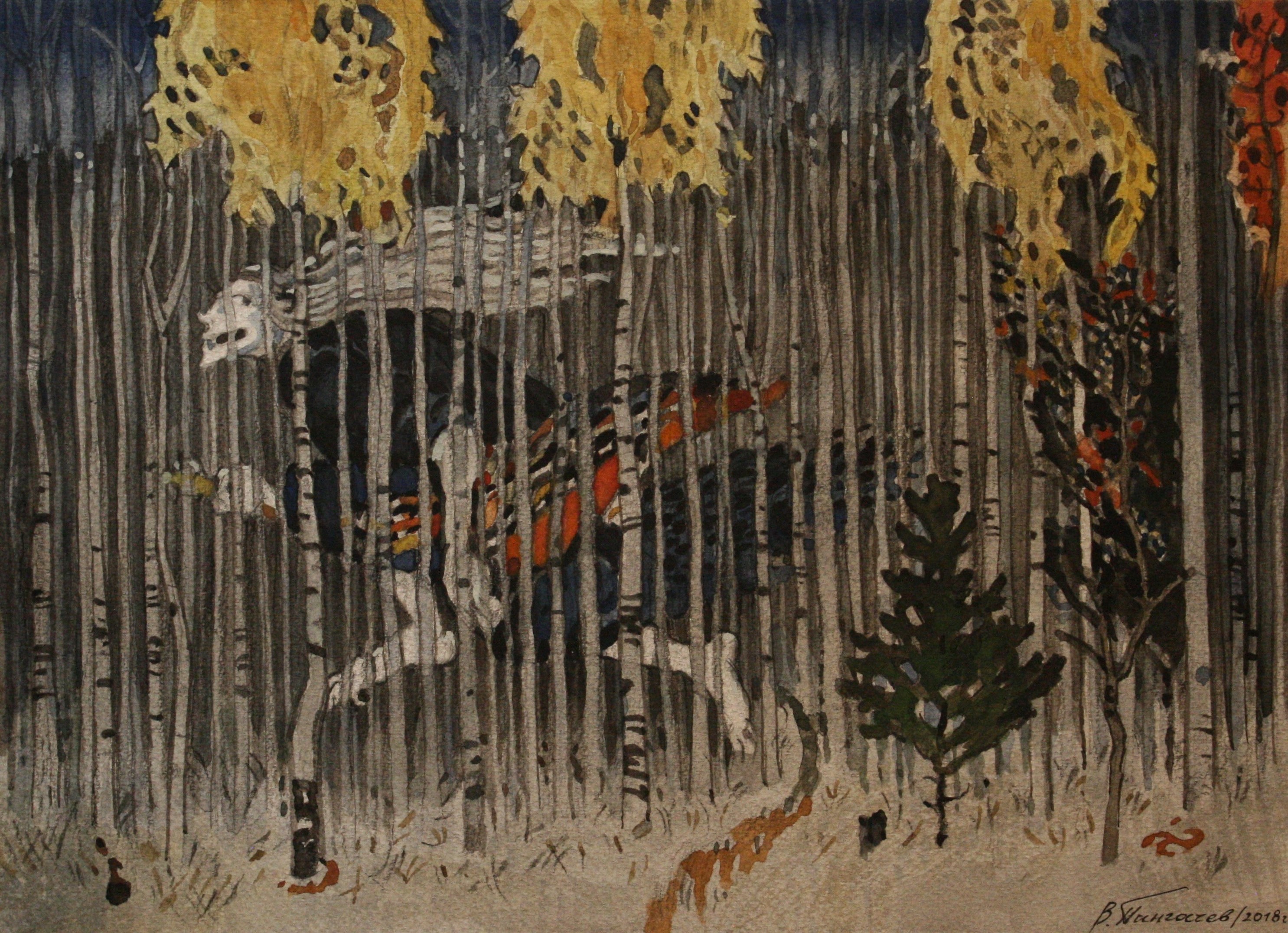

A house was left to me in the Dmitrovsky district—this is where my ancestors on my mother’s side are from—by my aunt. Though I was born in Moscow, I would usually spend my holidays in those parts. To this day, I go there every summer, and sometimes also in winter, spring, autumn.
Beyond the city, outside of civilisation, psychology alters significantly. It’s a different world there, everything is different there. And the thoughts one has there are different to those that usually arise in Moscow. You distance yourself from politics, from everyday problems. But this change does not take place immediately. Usually, a few days are needed for adaptation. At first, an inner dissonance appears: you feel yourself out of place, everything seems a little other. But then you get used to it, you are drawn into this new world. These days, I don’t go for long—a week or two. Work doesn’t let me linger. But when I was a schoolteacher, I would go for a month—there were the long summer holidays.
If you live in the wilderness for long enough, you become much more strongly integrated into the space of the place. You begin to feel, understand, see it more subtly. And if you don’t go out sketching for a long while, then after the break, you generally don’t see a thing—you don’t see colour, you understand tone badly. It’s only during the second or third session that something begins to appear. A plein-air session lasts around four to six hours, not longer. At home I tend to work around eight hours. It depends on the task: if I take on a preparatory drawing, then that can be done quickly, but if I’m bringing a work to its final form, then sometimes I need to sit at it from morning to night.
I walk about the outskirts of my village a lot. I like long-distance expeditions. And that’s where I get inspired. Everything you see in my works related to mythology comes from there. It can happen that I walk thirty kilometres in one day. Sometimes I hitchhike, if it isn’t possible to get somewhere on foot or the place is just too far away. I carefully work through the route beforehand, in order to make it simpler and easier to study a given place. It’s imperative that I be there: to examine the space, to understand how it functions.
Mainly, I walk about the places around my native village, but I also often go to Shatura. It’s more than a year already that I’ve been taken with bog science. And I haven’t done a bad job of studying all the bogs around Shatura. Petrovsko-Shaturskoye, Tugoleskoye. And I’ve found many interesting academic books on the subject. Naturally, they can’t be bought in shops, but they are available, thank God, on the Internet. I read them with the help of an electronic book. I want to understand how bogs are structured, what life there is in them. There many different kinds and different types, and all are equally interesting. Upland and lowland, oligotrophic and mesotrophic, all sorts, and each has its own vegetal composition. No two bogs are the same—even those that are alike.
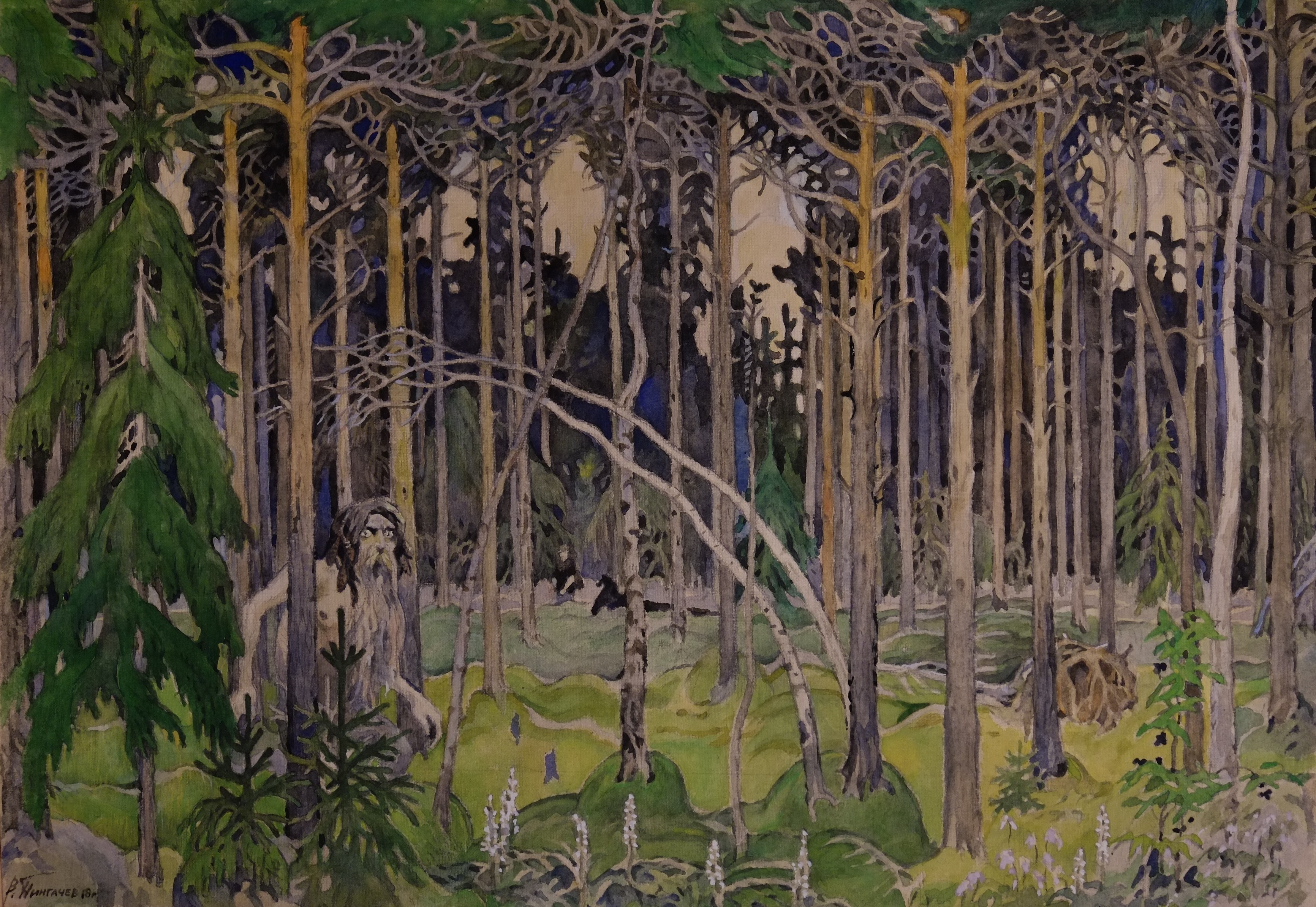
All of my travels are written down and recorded in notebooks. Here, for example, is a journey from this year, in autumn: “A journey to Drezna, to the Yurkinsky bog.” And here you can see my route drawn in. I explored this bog thoroughly—in one place I almost drowned. I’ve accumulated quite a number of such journeys over the years, I began making them back in 2013. They are purposeful, serious. Not far from Drezna there is another interesting bog, known as the Danilovskoe bog. It’s located on the route of the old road to Vladimir. These days there’s a reserve there, and within its bounds is the Danilovskoe bog, a surviving relic. What’s particularly interesting about the Danilovskoe bog is that they developed it in the 1950s, then left it alone. And the bog regenerated itself on its own, they didn’t even have to revive it. The peat layer is not very thick there, because the bog itself is relatively young. It’s around fifty years old. Maybe a little older. When you walk about it, you don’t drown, but the earth sways under you. The bog itself is open: due to the fact that the peat layer is thin, there are no large trees there. Every year, in those places, there are a lot of cranberries.
—I gathered cranberries around the Taldom bog last autumn.
Yes, it’s a boggy area. It’s also the native land of cranes. I also read about this in Prishvin. But Taldom is a lowland bog, whereas Danilovsky is upland.
I have read all of Prishvin. It’s even a shame—there’s no sense in taking his books at the library, I’ve studied all of them before. Prishvin truly began to write when he settled under Pereslavl. He ran a museum there, which houses a small boat that once belonged to Peter the Great. His house still stands in the village of Usolye to this day. I traveled to the Bludovo bog especially. I found Prishvin’s house, his granddaughter lives there now. In fact, it was from her I learnt how to get through Bludovo bog. “Don’t go there, you’ll get lost,” she says. And I answer: “It’s nothing, I’ll manage.” But it turned out she was right. I barely made it out of that bog. It’s really is easy to get lost there, it’s not for nothing they call it Bludovo. You lose your bearings in it immediately. It’s a good thing the sun was in the sky that day.
I have drawn a lot based on themes from Prishvin. He has this interesting story, “Drunk Road,” it describes a road going from village to a village. In one of the villages, there is a tavern. And this road goes through various terrible swamps, bogs, abysses. Men are constantly going along it to the tavern for vodka. The point is that the road doesn’t disappear anywhere over the years. Prishvin reasons that it must be kept up by a leshy. Had the road served some good purpose, and not people on their way to vodka, then the leshy would have flooded it long ago. There is no plot in the story as such—Prishvin creates a folk image, which, after reading, I tried to portray, to pass on. I also re-read all of Paustovsky in my youth, he and Prishvin are very close.
—Is that why you go to Meshchera?
Of course—Shatura is also Meshchera. The Tugoleskoe bog is actually located on the territory of the Meshchersky oblast. But where Paustovsky lived, near Ryazan, I haven’t yet been—these places are too far away. I still haven’t ever traveled overnight, unfortunately. I haven’t had the opportunity. But I really want to arrange at least a two-day trip. From time to time its hard for me on the way back, because I go a long way.
I have read a lot about the Vasyugan bog, which is located in Eastern Siberia. It spans several oblasts at once. Astafiev wrote about this bog, I really like that writer very much.
What do I need bogs for? You can’t just suck something out of your finger in creativity, it will be unconvincing. You have to fill yourself up with something first. When I taught at art school, I loved to cite an Eastern proverb to my students: “In order to pour something out of a vessel, you must first pour something in.” You see students often immediately begin the composition, they do it as if out of their heads, not preparing, not gathering material, without being inspired by anything. They rely on their own imagination, which, naturally, usually turns out very dull. That is unless they are very young children.
—You must also like Theodor Kittelsen?
I like him a lot. As well as being a writer, he illustrated his books himself. He has a short story titled “Forest Troll.” I found it on the Internet and even wrote it out for myself. Kittelsen created an interesting world of trolls, which is, by the way, very similar to the world of people. I think that as an artist he acted according to the same principle as I do. First, he would be inspired by something, by some images, which he would draw out of fairy tales, short stories, from Scandinavian folklore, then he would study space and find living images there. You often find them in nature. What do I mean—these fairytale, mythological images can be glimpsed when you are in a forest or a bog. I’m not confused by academic books written in dry language. There, of course, there are no artistic images—those I always find in another place. So, for example, I only take concrete information from the book Symbolism of Animals in the Slavic Folk Tradition by A. V. Gura. The mythological and fairytale images I glimpse, find in nature. It’s even far easier to see them there, to feel and to experience them.
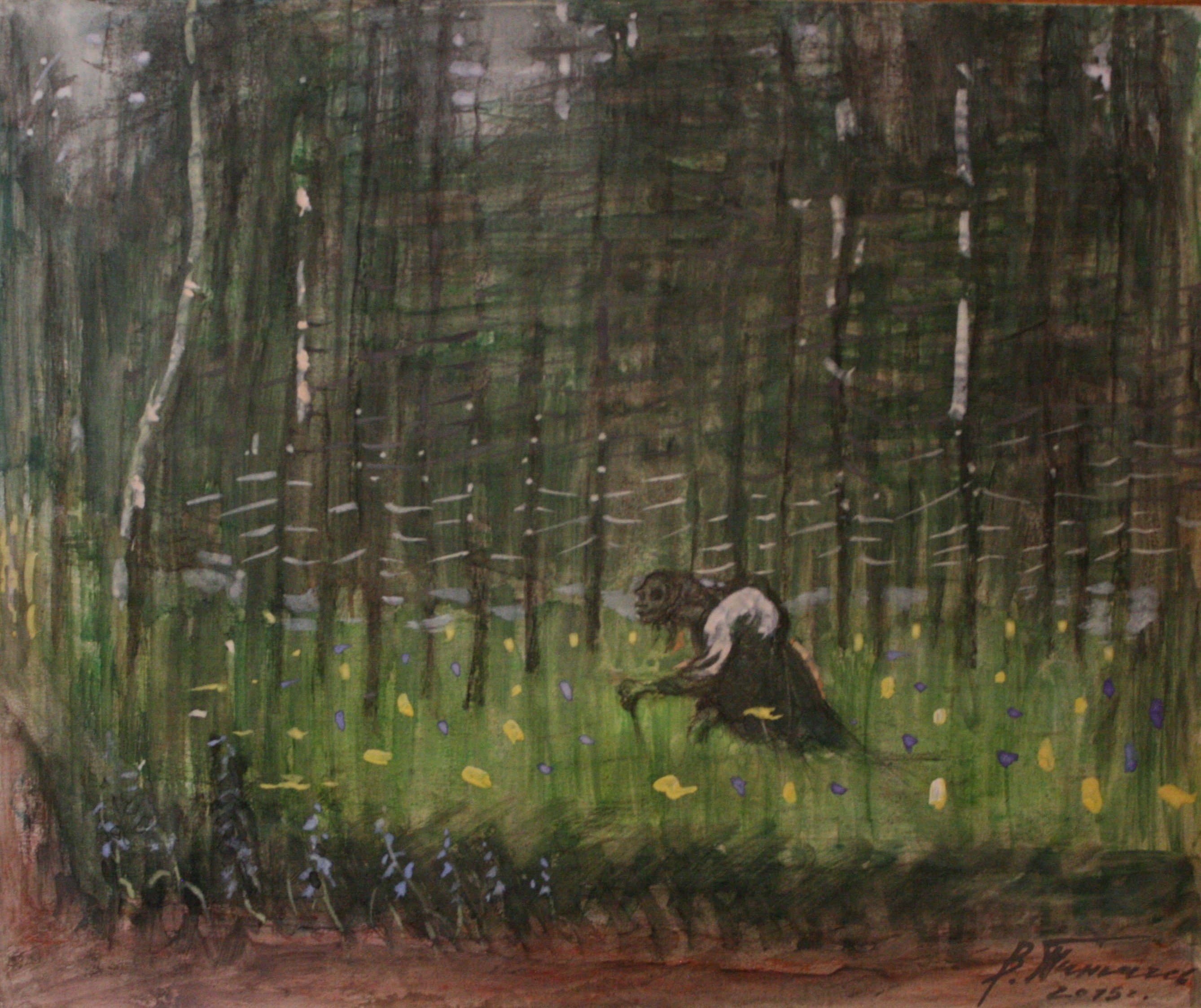
Sometimes there are dreadful places: you directly feel something undead, a spirit. Sometimes it even begins to seem to appear to you. And perhaps, of course, it all comes from you yourself. I am not a very superstitious person. That said, you can’t not be superstitious in nature. Especially if you get caught in a bog at twilight—then you begin to believe in all this immediately.
—And Will-o’-the-wisp?
No, I haven’t seen it, but I have heard voices. And, to my mind, it really was some kind of spirit. Afterwards, I found the day in the folk calendar—October 17, the day when spirits go underground. It’s written in the calendar that men shouldn’t go into the forest on that day. Because the leshy are raving. But as it happened I decided to go sketching in my village. Those noises were eerie. Though that said in the beginning, I thought that it was all the wind. Then the wind stopped, it was absolutely calm, but the sounds didn’t go anywhere. I could hardly bear it, but I finished the sketch. This happened in place that we refer to as Wolf Pit in our village. It’s considered a mystical place, magical. An enormous ancient pine stands there, three girths. Sometime long ago there was a placard hung on it, and the words “Do not touch the placard. Wood goblins hung it.” were written on the placard. I never saw this placard, but I’ve have heard about it more than once. In my time the placard on the pine was no longer there, but the tree itself was still standing. It was only in 2018 that they cut it down, when they began to expand the high-voltage line.
Actually, with time, a very interesting space forms under high-voltage lines, you see it’s neither forest, nor field, nor bog. It’s a kind of varied wasteland that constantly changes, every two poles. And there is an unbelievable variety of nature in these wastelands. No one would ever sow or plant anything under high-voltage wires, or build dachas, and thank God. But they also don’t allow trees to grow, they are felled, there are electrical wires above after all. And you end up with a world made up of all kinds of wasteland.
—I, on the contrary, really don’t like walking below electrical wires. There the tracks are usually damaged, the roads uneven.
We don’t have anything like a road along the electrical wires. Before, in the 1970s, there was a path in that place. We would walk along it to the Trekhsvyatsky village on the Sestra river to bathe. But now there isn’t even that path. In fact, as it happens, it’s very difficult to walk under electrical wires, through those wastelands. There are these boggy places where the grasses are higher than human height, you can’t get through.
Yes, there used to be many roads: ancient roads, forest roads, village roads. And they were interesting phenomena. Every road has its own character, its own image. I have an entire work dedicated to a single road—Recollections of Old Sapryginskaya Road. Today, the road has entirely petered out, though there are still some places in the forest that let you guess it once existed. But once it really was very interesting.
—What do you think, if in some book from the beginning of the twentieth century there were to be a detailed description of the places you often go, would you be able to bring the text to life in your imagination and discern in it the features of a space well known to you?
I think I would be, if I set myself such a goal. I have never done this though, as nothing of interest has been written about our places. I have only an old map, from the 1880s. More than once I’ve studied it and compared it with what is there now. Very much has changed, of course. All the old roads used to run absolutely differently. In the time of my childhood, and even in the 1980s, the roads indicated on that map still functioned, but now almost all of them have disappeared. Though that said before there wasn’t the main road on which everyone travels now. The road unites all the local villages. The new road doesn’t go directly from village to village, as the old ones ran: in the old days, after all, all roads ran in a straight line, the shortest way. The roads wound, but the route itself was direct. But now the route is roundabout. To get to the Trekhsvyatsky village, you have to first go through Nechaevo and Chernyaevo. But before there was a direct road from Bogdanovo to Trekhsvyatskoe. Then there were roads between all villages. They were village roads of course, curved, field roads, sometimes even boggy—we called them bridges. But it was a direct route, the shortest. Now they’ve gone and made one big grader for all the villages, and you end up with a hooked road. The old roads have practically disappeared, but their great number complicated the space. It was possible to go everywhere freely.
—Actually, as well as natural visual information and factual information taken from research, there is one more important source of information—so called poetic folk creation, folklore.
I have a cycle, Spirits, you have probably seen some works from it on the Internet. It’s dedicated to this very theme. In it I studied space and its relation to folkloric creatures in particular. What are all these leshy, kikimora, poleviki, bolotniki? They are the spirits of places. In Scandinavian mythology, and in Kittlesen, they are called trolls. Every place has its own spirit, its own particular troll. They can be very different: small, big, everything depends on the place. The spirit of a place looks the same as the place itself. It corresponds to it. In our tradition, in our folklore—it’s the same. To each forest—its own leshy. In each bog, its own bolotniki, its own kikimora. And so on. When I was working on that cycle, I studied particular places in the nature especially. I would find a new space, unknown to me until then, and then try to find the spirit of the place, to understand it, to feel it. All of this is necessary in order to be able to better imagine to yourself how the leshy looks. My task is not to find some abstract leshy, but to find the particular one that lives in a particular place, the spirit of that place.
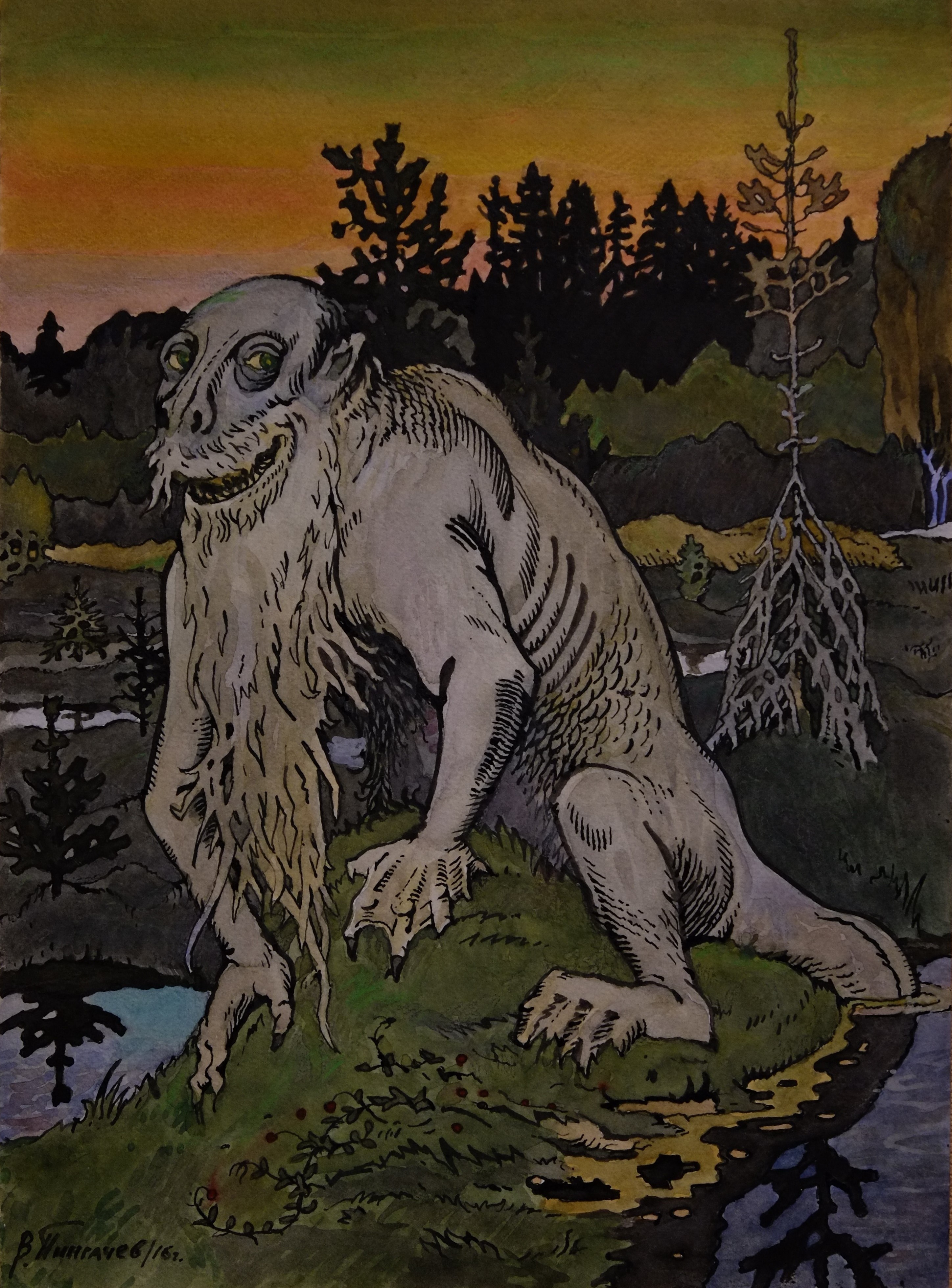
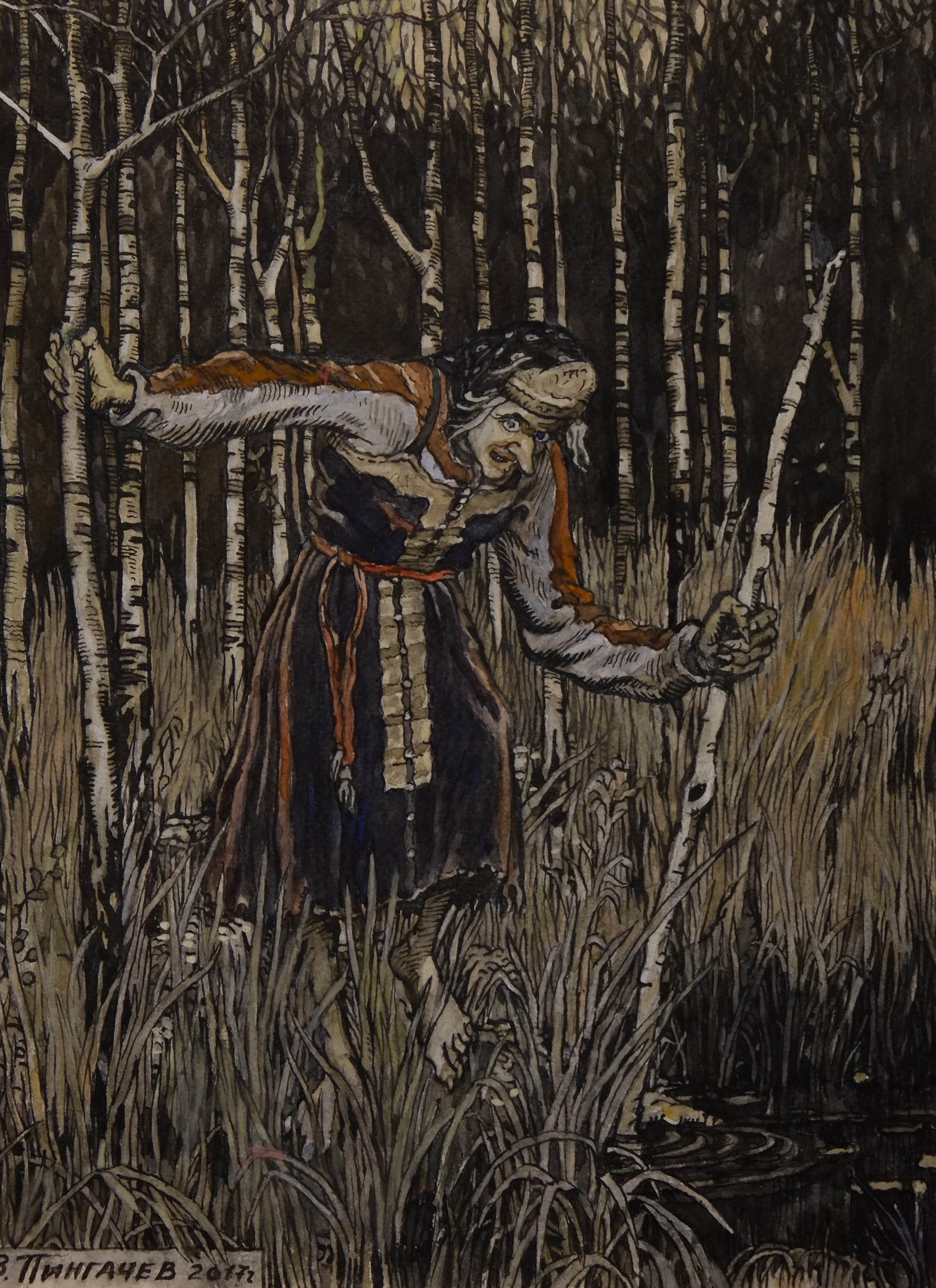
Sometimes it happens that one forest is similar to another in terms of vegetal composition—mixed, for example—yet all the same differs from it. Each, once again, has their own space, their own light, their own atmosphere. And the pieces of the puzzle always come together differently. Let’s say you have a mixed forest: fir tree, pine, birch, undergrowth—mountain ash, some kind of wolfberry, juniper. From these elements you can create many different kinds of forests. Like phone numbers in a book: only nine figures, but think of how many numbers you get from them! The same goes here. Except that one needs to bear in mind the landscape itself. It might be a hill, a lowland, or an endless plain, like Shatura, the swamps. This plane is felt directly there. You don’t see it, but you feel it, a vast eternity that’s disappearing somewhere, an absolutely equal surface.
2
—Thank you for having agreed to a second recording—last time my dictaphone bizarrely recorded an hour and half of silence instead of the second part of our conversation. That said, it’s in good order, I checked. In the past, I had heard about this kind of thing only from folklorists—“Turn off the microphone, I will now read out a spell or tell you a secret.” And they pretend to turn it off, but then it turns out that instead of the spell or the secret all that was recorded on the tape was a barely perceptible hiss, nothing else.
It’s miraculous, of course, but I’ve encountered similar things. And I don’t joke around with these things. Especially when I am in nature. Here, in Moscow, I might be able to make light of it, in the city I’m partly an atheist. But when there is nature all around, being an atheist is not easy.
—Are you able to determine the character of an unknown forest from the outset, by its outward appearance?
Of course, that’s how I do it in general. Once, I happened on a particular forest and immediately felt its image. I told myself: “Without a doubt, Baba Yaga lives here.” It was a fir forest, very old, practically on the bank of the Sestra river. There was no light there, there was no greenery below. Everything was grey. The greenery was somewhere far up above, I practically couldn’t see any. The lower branches of the fir trees had dried up long ago, all there was around them was a thick bedding of spruce needles and darkness. Day and night a grey darkness and misty haze.
—Are there any concrete signs or distinguishing features that allow you to confidently determine whether or not Baba Yaga is present in a given forest?
You can simply tell from the feelings. An artistic image appears before you, and you consider it. It becomes evident that the location accords with the image of Baba Yaga, that’s all it takes. Generally, fir forests are the gloomiest, the darkest of forests. Young fir forests are usually merry, cheerful. But those are small firs. When they grow, it’s terrible. Old fir forests are very frightening.
I read in some book that the oldest forests in the middle range are, as it happens, fir forests. First birches grow, then mixed black forest, and only then does the third generation of forest appear—the firs rise, and soon all the forest has become fir. The oldest forests in our parts are fir forests. Of course, very few of them are left now. In the Middle Ages, for example, dark fir forests prevailed. Then they didn’t fell trees in vast quantities. But today they fell trees and don’t plant anything in their place. Birches grow right away. And on the rare occasions they do plant something, then more often that not, fir trees and pines grow. It’s very merry in those places, I love such cheerful clearings. Clearings, by the way, are also a particular kind of space.
—In this case, could we consider, say, the destruction of the shelters of wild boars a particular kind of space too? They tear apart large spaces for their needs, after all.
Once I came across an entire boar district in a forest. On that day I’d been walking around a bogged area for a long time, through very high grasses, and suddenly I found myself in absolutely impenetrable and dense undergrowth. There were paths there that resembled human paths, but that was only how it seemed—making my way along them through the forest, I would, from time to time, stumble upon what you might call a kind of apartment, that is, a boar shelter. Thank God, this was during the day—and I didn’t meet any animals. But the place was very dense, I barely made it through that labyrinth. I knew in which direction to go, but getting through was practically impossible, everything was so overgrown. I doubled back and wandered along the boar paths.
In the end I was somehow able to get out onto a small river, a tributary of the Sestra river. The Trekhsvyatskoye village was visible very nearby, across a field. All one needed to do was get past the water barrier. I found a place where you could cross, I jumped across the river, suddenly someone grabs me from behind… I had actually got caught on a bush branch, but I had the feeling that a kikimora I’d unwittingly been visiting had grabbed me. And there were many similar episodes as I clambered through those thickets. You stumble, and it’s as though someone tripped you. You look, and on the ground there’s a bough shaped like a hand. All of this, of course, is my artistic imagination, I understand this, but all the same, sometimes these spirits have even saved me. Helped out when I have fallen into one or another difficult situation in a bog or a forest. I would feel that some kind of local spirit was helping me. But sometimes they interfere with you, like the kikimora. Clearly, I was her guest, and she didn’t want to part with her guest.

—If people harm one or another natural space, they must also harm the spirits living there?
Of course. Leonid Leonov, for example, often raised the issue of the destruction of spirits’ places of habitation in his stories. There’s something about this in his story “Buryga.” Lumberjacks walk into a pine forest, began to cut down the trees. A number of different leshy lived in those parts, among them Buryga. They were not similar to one another—they also apparently differed depending on the place they lived. Leonov describes their outward appearances very well. The other two leshy are not at all similar to Buryga. Leonov gives a lot of attention to the outward appearance of these creatures. In the end the Buryga emigrates, gets as far as Spain. It’s a very complicated story, mysterious. But his departure was related to the fact that the pine forest where the chief leshy lived was bought by a merchant who sent in lumberjacks to cut down and sell the wood. And then the old leshy who had bee in charge of the forest takes off, changes into civilian clothes, and becomes a man. He even gets himself a passport. And goes off to some other place. The story also has a very detailed description of how he survives. At the beginning, he scares the lumberjacks—he tries to deal with them himself. But then he understands that nothing will come from this. And so he decides to emigrate. And along with him, all the smaller leshy also flee from those parts. And the main character, Buryga, lives through many different adventures and, in the end, ends up in Spain. But then all the same he comes back. It’s a very interesting story about love for one’s native land actually.
—Fallen trees have always played an important role in painting. What do you think of them?
Why is it difficult to walk straight through a forest? Because of all the so-called deadwood everywhere. Especially if the forest is old, and its forester bad. You end up having to loop around a lot. And that’s why its so easy to get lost, especially if you’re without a compass. You begin to go around these fallen trees and you quickly lose your bearings. If you were going straight, then it would be a simple matter to keep your bearings, but usually you end up having to loop around.
You often come across very interesting looking dead trees in forests. I sketch those that look like forest creatures. I got a sitting leshy from one. I drew it from life. And I also got a lame leshy on crutches. He was standing right by the road, very small. And I drew him straightaway on the spot.
Before, when I had more time, I would constantly make sketches during expeditions. It’s a kind of note-taking, from which you can then make a composition. You look at those drawings and immediately you understand everything. I’ll find it now. Here—the lame leshy. I drew him from life. Tied up with a handkerchief—clearly his head hurts, or his ears.
If, let’s say, a person believes in such creatures, then they will consider that they are the ones that create the space around them. That’s why you can’t say that I think up my characters. I saw that lame leshy in reality after all, I didn’t think take it from my imagination.
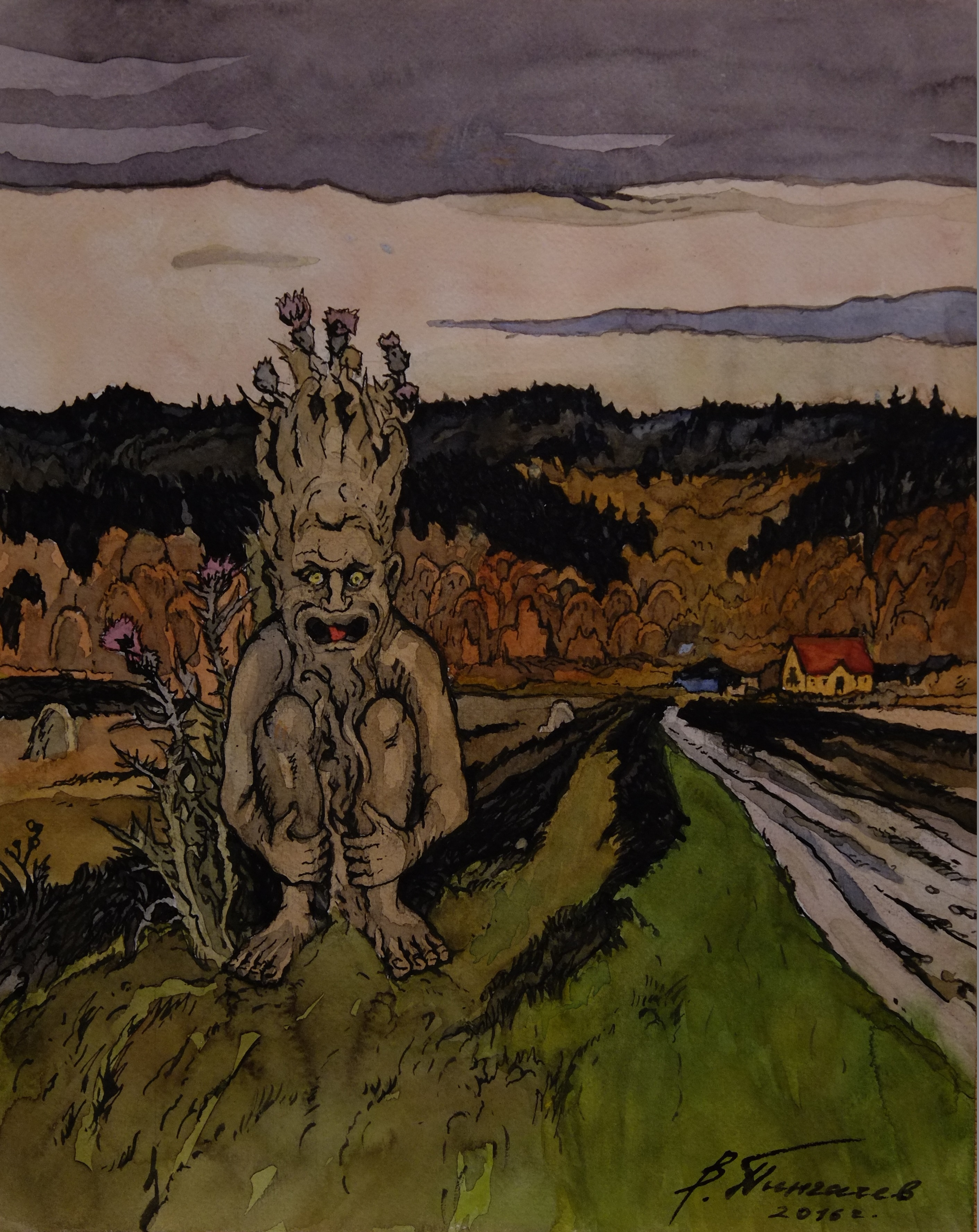
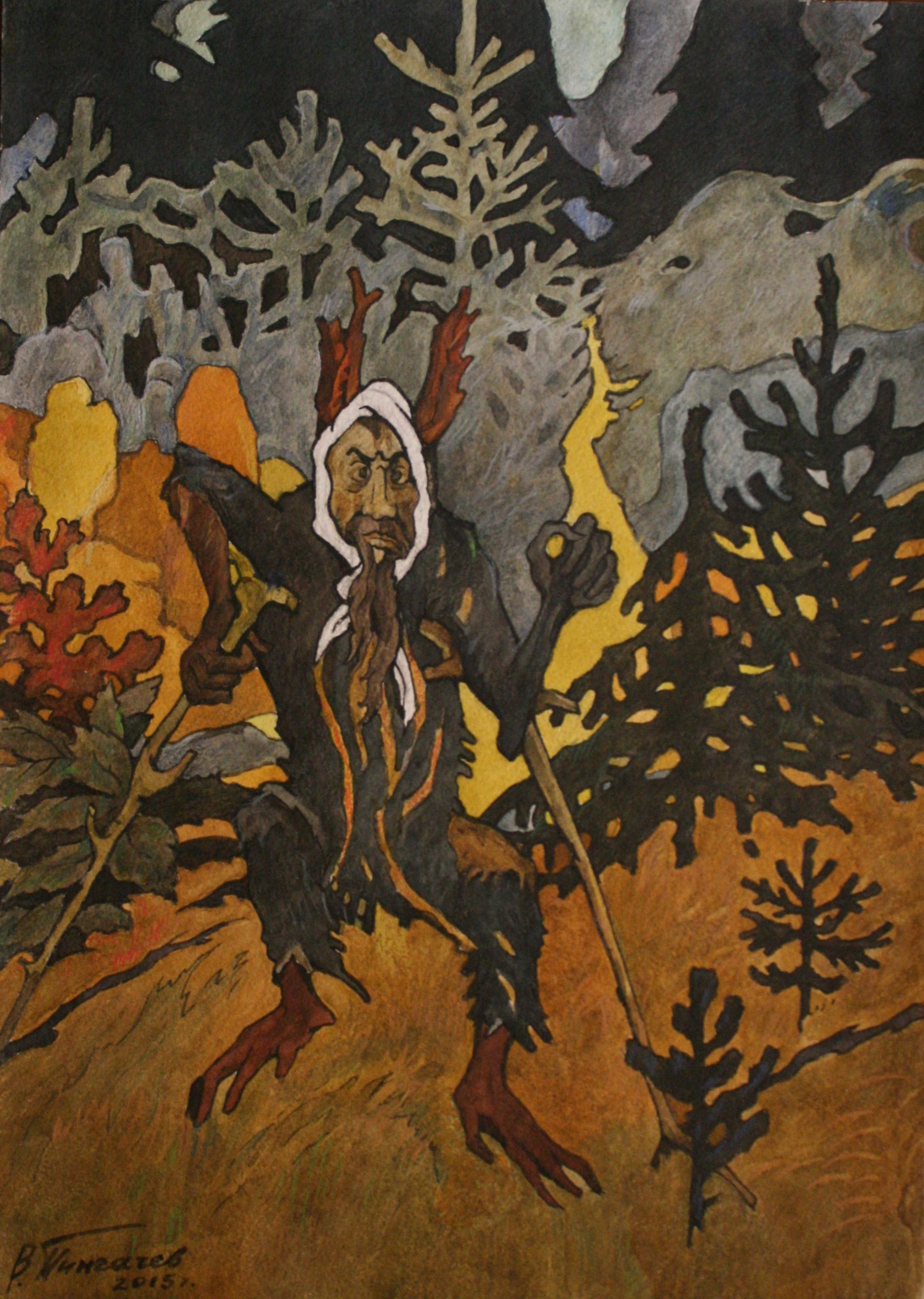
The character of a represented creature depends directly on the place. If before me there is a young birch forest, then the creature will correspond to this place in character. It will certainly not be angry and gloomy. And if, for example, it’s a dense fir forest, then leshy will correspond to it. In my “Spirit” cycle works are named not after the creatures themselves, but after the places from where I took them. I have, for example, a work titled Fir Birch, which depicts a very cheerful, sunny forest. And in this forest the leshy are cunning, crafty, malicious. And I have another work, called Haircap moss (or cuckoo’s flax, if translated ad verbum from Russian). That’s where I saw a forest witch, Baba Yaga, shishiga. And she’s not so strange there, she corresponds with the space around there. In that painting the atmosphere comes from small flowers, from the haircap moss. This plant has almost no leaves, only blue-white flowers.
—You often talk about space, both in relation to art, and in relation to everyday life—in your opinion, are they one united space or two different ones?
Let’s begin with art. Fine art is spatial, in contrast, for example, to literature. Theatre is both a temporal and a spatial art. This was how the academic Andrey Vasnetsov taught me. He would say that the main thing is to understand space, to be able to construct it. Space is not emptiness in which objects are located, it is a very complex phenomena, in which everything is interrelated. In art, space is represented in the form of relief, and emptiness is also an object. Space and its understanding is the main thing for the artist. That’s why I study it so attentively.
But, on the other hand, space is a universally understood concept. You also take your bearings from it in every day life. Though everything is very bad regarding this today. A person is used to the navigator, which will always tell you where you are. I purposely go on my expeditions, even the most complicated, without any of this assisting material. I only take a small map with me, which I draw earlier, by hand. I put before myself the task of learning to better find my bearings in space. It’s a difficult task, sometimes even a little frightening. You go to the Tugoleskoe bog, and then you have to get through tens of kilometres of swamps, and you don’t even really know the route, you don’t know whether the path is before you or not, whether there will be any landmarks.
I always take my bearings from time. Time is distance, after all. Let’s say I walk for an hour and understand that I’ve gone around four kilometres. If I need to turn onto a road that is a kilometre and a half away from me, then I’ll measure everything by time. There are many roads. You end up turning where you shouldn’t. I have had occasions where I’ve walked into dreadful thickets. That’s why the main thing on journeys is a compass and a watch. You won’t get anywhere without them.
But losing your way not infrequently turns out to be a good thing, allowing you to learn something new. At first, of course, you’re scared, you’re lost after all, you’ve ended up you don’t know where. Once I wandered into a terrible wilderness. I stumbled upon a kikimora house there. Though of course it wasn’t a Kimora house. But I really don’t know what it was. A terrible horror. Maybe hunters lived there in the summer. This happened in the most remote corner of the Tugoleskoe bog, where there are a lot of ducks. I had walked the twenty kilometres there from the railway station through such thickets, hunters’ paths… everything was flooded all around. And in the end I came upon this terrible house. Everywhere there were these rags hanging from the trees, the house itself was disturbing. I was so scared I couldn’t leave there before having looked into the house. I forced myself to do it. There was, of course, no one there.
—For some reason I’ve just remembered that sometime long ago I heard a story about Andrey Bely, the truthfulness of which I haven’t, unfortunately, been able to confirm or deny. The point of the story is in that he somehow decided to take on the classification of sunsets and took to carrying out observations every day, describing in detail the sky as the sun set, how it changed.
It’s a shame you don’t know the source of this story. In my village I always eat in plein-air. Once I’ve finished all my work, between 9 and 10pm, I set off for somewhere not far from home, taking with me a bottle of port wine, some appetisers, and I stand and observe the sunset. I haven’t seen two identical sunsets once, though I go out practically every day. Each day has its own new sunset. Once I saw this marvellous sunset—I called it “The Battle of Poitiers” to myself. Then I immediately made sketches at home from memory, and then later I painted a history painting based on that sunset. The sky was dark, blue-grey, and it was cut through the middle by a golden horizontal stripe. Sunsets really do repeat themselves when the weather is hot and dry. But even then they are somewhat different from one another.
sreda@v-a-c.org
All rights reserved. Reproducing or using the materials from this web-page without written consent of the rightsholder is forbidden.